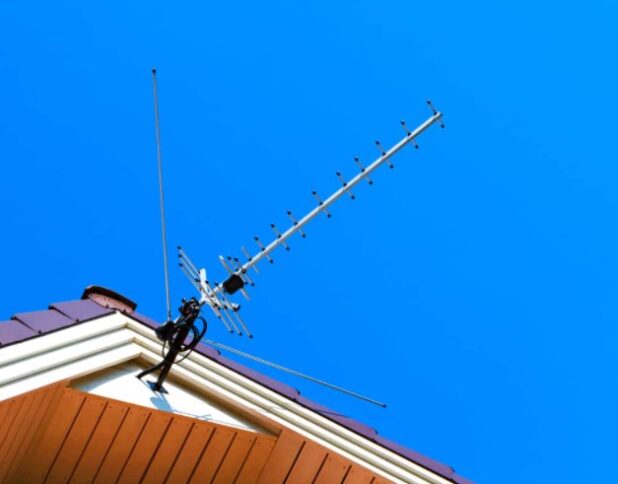Earlier, people used to install antennas mainly on the top of their houses to receive signals from various channels for free. It is a great way to cut the cords or cable costs and save money. Also, the cable does not allow you to watch many local channels, which you can easily find by using a TV aerial.
Are you looking forward to installing a second TV in your home but don’t want to pay the cable bills? If yes, then getting an aerial would be the right choice for you. It is an easy and quick solution to get entertainment without paying any price.
However, most people get confused about which antenna they should choose: indoor or outdoor. In this article, we will be discussing indoor and outdoor antennas so that you can make the right decision for yourself.
Table of Contents
Indoor TV Antenna

If your house is near the towers of TV broadcasts, indoor antennas can be the perfect solution for you. Also, it is an excellent option for those who live in apartments in big cities where they cannot manage to install an outdoor aerial. These are compact and powerful at the same time. They can be placed inside the room as they don’t occupy much space.
However, you need to understand that various building materials such as wood, bricks, or metals can interfere with the transmitting signals while installing the aerial. Apart from this, many of your household appliances can also become an obstacle to receiving signals.
To avoid any such interference, we suggest you place the antenna somewhere near the window of your room in the direction facing the broadcast towers. This is one of the best positions to receive strong signals from the tower nearby you. If you are still not sure about it, then you can take some professional help at www.tayloraerials.co.uk.
Outdoor Tv Antenna

Outdoor aerials provide you with the best opportunity to receive strong signals. These are mostly mounted on the rooftops. However, you must install it with no obstruction created by the trees, walls, buildings, or other roofing substances. It is a perfect option for people who do not live near any local broadcast towers. The indoor antennas can’t receive strong signals from the towers located far distances.
Outdoor aerial can likewise be mounted onto the sides of one’s home, decks, or on a stand from the ground floor where you have access to the roof. Keep in mind, test your aerial position by examining the accessible channels before boring any openings.
If you are experiencing issues with your setup, try contacting your neighbors to know whether they are also experiencing problems getting channels. If they have comparative issues with a specific channel, contact experts in your local workplace to resolve such issues.
5 Tips For Installing Antenna In Your Home

1. Finding out the broadcast towers located in your region
The first thing you need to pay attention to while installing the aerial in your home is to look for the broadcast towers nearby your location. You must know where the towers are situated before you buy the aerial. It will help you identify what type of antenna you require to receive powerful signals from the tower.
One of the best platforms to find out the location of broadcast towers is TV Fool. All you have to do is fill in your address on this platform, and it will show you the exact distance between your house and every tower present in your region.
2. Placing the aerial near the window
While introducing a TV aerial in your home, you need to ensure that there is possibly no or most minor obstruction between the aerial and the signal transmission towers. To avoid any obstacles to create interference in the signals, you should consider placing the antenna near the window.
However, there is one issue that can arise from this. You don’t want your antenna to get exposed to the scorching heat of the sun for a longer time. In such a case, you must ensure that the white side of the antenna faces the sun because white absorbs the least amount of heat.
3. Place it at greater heights

Another factor that you need to keep in mind while installing the TV aerial is height. The higher you will place it, the better signals you will receive. This is the reason why outdoor aerials are known to receive much stronger signals than indoor ones. Therefore, try to place the antenna as high as possible for you on your rooftop.
4. Try to keep metals away from the aerial
Metallic surfaces close to your TV aerial can cause transmission impedance and even block the signals. For instance, if you place your aerial in a window yet, there are metal thief bars or a metal bug screen right outside the window; this could cause issues. Moreover, if you have a metal rooftop in your home, introducing your antenna in the upper room likely will not yield positive outcomes.
5. Assemble all the tools and material beforehand
Before starting the installation work, you need to ensure that you have all the tools and the material present with you. You will require various tools during this task, such as hammer, driller, wire cutter, ladder, etc. Always take precautions while using these tools to avoid any injury or mishappening.
Other materials you will need include an antenna, cords, screws, mounts, and a splitter if you wish to split the connection between two or more televisions. Arrange all the material and tools beforehand to avoid any trouble at the last minute.
To Sum Up
Indoor antennas are ideal for people who do not have access to roofs, and their home is located near the broadcast towers. However, if broadcast towers are situated away from your location, you should consider choosing an outdoor antenna to receive better signals.
 World Magazine 2024
World Magazine 2024






